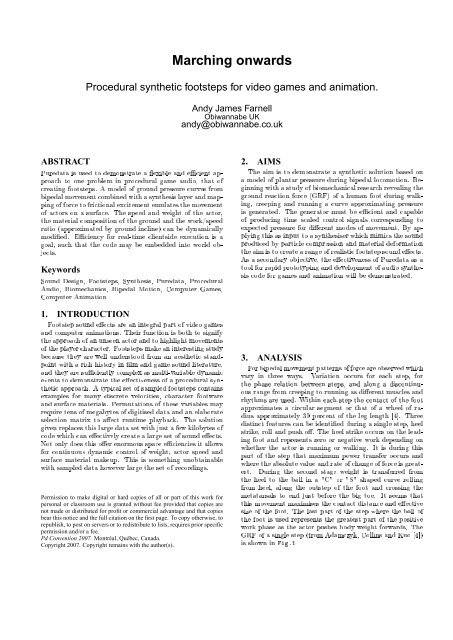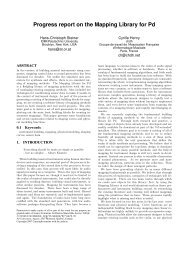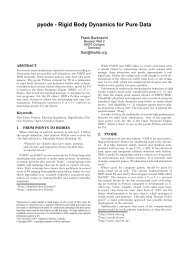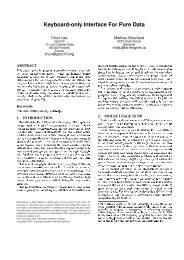Procedural synthetic footsteps for video games and ... - Obiwannabe
Procedural synthetic footsteps for video games and ... - Obiwannabe
Procedural synthetic footsteps for video games and ... - Obiwannabe
You also want an ePaper? Increase the reach of your titles
YUMPU automatically turns print PDFs into web optimized ePapers that Google loves.
Marching onwards<br />
<strong>Procedural</strong> <strong>synthetic</strong> <strong>footsteps</strong> <strong>for</strong> <strong>video</strong> <strong>games</strong> <strong>and</strong> animation.<br />
Andy James Farnell<br />
<strong>Obiwannabe</strong> UK<br />
<strong>and</strong>y@obiwannabe.co.uk<br />
ABSTRACT<br />
Puredata is used to demonstrate a exible <strong>and</strong> ecient approach<br />
to one problem in procedural game audio, that of<br />
creating <strong>footsteps</strong>. A model of ground pressure curves from<br />
bipedal movement combined with a synthesis layer <strong>and</strong> mapping<br />
of <strong>for</strong>ce to frictional excitement emulates the movement<br />
of actors on a surface. The speed <strong>and</strong> weight of the actor,<br />
the material composition of the ground <strong>and</strong> the work/speed<br />
ratio (approximated by ground incline) can be dynamically<br />
modied. Eciency <strong>for</strong> real-time clientside execution is a<br />
goal, such that the code may be embedded into world objects.<br />
Keywords<br />
Sound Design, Footsteps, Synthesis, Puredata, <strong>Procedural</strong><br />
Audio, Biomechanics, Bipedal Motion, Computer Games,<br />
Computer Animation<br />
1. INTRODUCTION<br />
Footstep sound eects are an integral part of <strong>video</strong> <strong>games</strong><br />
<strong>and</strong> computer animations. Their function is both to signify<br />
the approach of an unseen actor <strong>and</strong> to highlight movements<br />
of the player character. Footsteps make an interesting study<br />
because they are well understood from an aesthetic st<strong>and</strong>point<br />
with a rich history in lm <strong>and</strong> game sound literature,<br />
<strong>and</strong> they are suciently complex as multi-variable dynamic<br />
events to demonstrate the eectiveness of a procedural <strong>synthetic</strong><br />
approach. A typical set of sampled <strong>footsteps</strong> contains<br />
examples <strong>for</strong> many discrete velocities, character footware<br />
<strong>and</strong> surface materials. Permutations of these variables may<br />
require tens of megabytes of digitised data <strong>and</strong> an elaborate<br />
selection matrix to aect runtime playback. The solution<br />
given replaces this large data set with just a few kilobytes of<br />
code which can eectively create a large set of sound eects.<br />
Not only does this oer enormous space eciencies it allows<br />
<strong>for</strong> continuous dynamic control of weight, actor speed <strong>and</strong><br />
surface material makeup. This is something unobtainable<br />
with sampled data however large the set of recordings.<br />
Permission to make digital or hard copies of all or part of this work <strong>for</strong><br />
personal or classroom use is granted without fee provided that copies are<br />
not made or distributed <strong>for</strong> profit or commercial advantage <strong>and</strong> that copies<br />
bear this notice <strong>and</strong> the full citation on the first page. To copy otherwise, to<br />
republish, to post on servers or to redistribute to lists, requires prior specific<br />
permission <strong>and</strong>/or a fee.<br />
Pd Convention 2007. Montréal, Québec, Canada.<br />
Copyright 2007. Copyright remains with the author(s).<br />
2. AIMS<br />
The aim is to demonstrate a <strong>synthetic</strong> solution based on<br />
a model of plantar pressure during bipedal locomotion. Beginning<br />
with a study of biomechanical research revealing the<br />
ground reaction <strong>for</strong>ce (GRF) of a human foot during walking,<br />
creeping <strong>and</strong> running a curve approximating pressure<br />
is generated. The generator must be ecient <strong>and</strong> capable<br />
of producing time scaled control signals corresponding to<br />
expected pressure <strong>for</strong> dierent modes of movement. By applying<br />
this as input to a synthesiser which mimics the sound<br />
produced by particle compression <strong>and</strong> material de<strong>for</strong>mation<br />
the aim is to create a range of realistic footstep sound eects.<br />
As a secondary objective, the eectiveness of Puredata as a<br />
tool <strong>for</strong> rapid prototyping <strong>and</strong> development of audio synthesis<br />
code <strong>for</strong> <strong>games</strong> <strong>and</strong> animation will be demonstrated.<br />
3. ANALYSIS<br />
For bipedal movement patterns of <strong>for</strong>ce are observed which<br />
vary in three ways. Variation occurs <strong>for</strong> each step, <strong>for</strong><br />
the phase relation between steps, <strong>and</strong> along a discontinuous<br />
range from creeping to running as dierent muscles <strong>and</strong><br />
rhythms are used. Within each step the contact of the foot<br />
approximates a circular segment or that of a wheel of radius<br />
approximately 30 percent of the leg length [4]. Three<br />
distinct features can be identied during a single step, heel<br />
strike, roll <strong>and</strong> push o. The heel strike occurs on the leading<br />
foot <strong>and</strong> represents zero or negative work depending on<br />
whether the actor is running or walking. It is during this<br />
part of the step that maximum power transfer occurs <strong>and</strong><br />
where the absolute value <strong>and</strong> rate of change of <strong>for</strong>ce is greatest.<br />
During the second stage weight is transferred from<br />
the heel to the ball in a "C" or "S" shaped curve rolling<br />
from heel, along the outstep of the foot <strong>and</strong> crossing the<br />
metatarsals to end just be<strong>for</strong>e the big toe. It seems that<br />
this movement maximises the contact distance <strong>and</strong> eective<br />
size of the foot. The last part of the step where the ball of<br />
the foot is used represents the greatest part of the positive<br />
work phase as the actor pushes body weight <strong>for</strong>wards. The<br />
GRF of a single step (from Adamczyk, Collins <strong>and</strong> Kuo [4])<br />
is shown in Fig.1
Figure 1: GRF Human step<br />
3.1 Phases<br />
The bipedal duty cycle <strong>and</strong> overlap varies considerably<br />
according to velocity. The overlap, or phase, is increased <strong>for</strong><br />
slower walking speeds <strong>and</strong> decreases towards running speed.<br />
The use of the phrase "break into a run"suggest some degree<br />
of discontinuity between walking <strong>and</strong> running modes.<br />
This seems best dealt with by applying an intervening nonlinear<br />
function to the actor velocity variable to set the desired<br />
inexions. While the pattern of ground reaction <strong>for</strong>ce<br />
is largely the same <strong>for</strong> each step, though compressed or dilated<br />
with changing actor velocity, the phase of steps <strong>and</strong><br />
the vector of <strong>for</strong>ces corresponding to useful locomotive work<br />
changes between slow <strong>and</strong> fast movement. While accelerating,<br />
the actor body must do more work which increases the<br />
<strong>for</strong>ce found in the push-o phase when the ball is in contact.<br />
When slowing down <strong>for</strong>ce is shifted to the heel impact<br />
where negative work is done. Phase <strong>and</strong> amplitude variations<br />
considered below <strong>for</strong> three modes of movement, each<br />
of which produces a distinctive pattern strongly suggestive<br />
of that human movement mode when applied to a suitable<br />
synthesis unit.<br />
3.2 Creeping<br />
The creeping cycle (Fig.2a) is most obviously found in<br />
predators where evolutionary advantage is obtained by minimising<br />
sound during movement. Since sound output can be<br />
approximated by rate of change of pressure the predator obtains<br />
stealth by an even application of pressure, corresponding<br />
to dominance of the roll phase in hominids. This mode<br />
is characterised by an increased overlap of plantar contact<br />
so that weight is distributed carefully over both limbs.<br />
3.3 Walking<br />
Walking may be characterised as a compromise of eective<br />
locomotion, minimisation of stress <strong>and</strong> metabolic cost. The<br />
phase overlap varies between about 10 percent <strong>and</strong> 20 percent<br />
of duty cycle (Fig.2b). [4] When walking, the kinetic<br />
energy given by the velocity of the body mass <strong>and</strong> the sum<br />
of kinetic <strong>and</strong> potential energy due to raising the body mass<br />
have opposite phase. Kinetic <strong>and</strong> potential energy are exchanged<br />
in a pendular mechanism such that muscular work<br />
<strong>and</strong> movement of the center of mass reduced. [3]<br />
Figure 2: Left-Right phase <strong>for</strong> dierent movement<br />
speeds.<br />
3.4 Running<br />
Running (Fig.2c) can be considered a maximisation of<br />
locomotion [2] In running, kinetic energy of the body mass<br />
<strong>and</strong> potential energy are in phase, which suggests a bouncing<br />
mechanism. [3] The transition between heel contact <strong>and</strong> ball<br />
push-o is signicantly reduced <strong>and</strong> the phase overlap <strong>and</strong><br />
heel phase amplitude tend to zero. In this mode the actor<br />
has at most one foot in contact with the ground at any time<br />
<strong>and</strong> <strong>for</strong> fast movement can be completely airborn.<br />
4. METHOD<br />
First we obtain an acceptable approximation of the GRF<br />
signal. The experimental setup consisted of Puredata, Octave<br />
<strong>and</strong> Gnuplot, some recordings of <strong>footsteps</strong> <strong>and</strong> Audacity<br />
<strong>for</strong> spectrum plots. From example recordings, plots of<br />
mean amplitude were taken in frequency b<strong>and</strong>s appropriate<br />
to a small set of materials, namely grass, snow, gravel, wood,<br />
metal <strong>and</strong> dirt. Each of these identies features appropriate<br />
to a change in the GRF signal. Features of real sounds<br />
correlate nicely to the the measured <strong>for</strong>ce values of Fig.1<br />
Because there are two feet which must overlap in phase the<br />
Puredata program shown is an abstraction <strong>for</strong> one foot, in<br />
synthesis a pair of these are used. The synthesis settings<br />
discussed are <strong>for</strong> gravel, which makes an eective demonstration<br />
being typical of the friction-excitation behaviour of<br />
many materials.<br />
4.1 Control signal by superposition of cosines<br />
The rst attempt to approximate the observed data eciently<br />
used three half cycles of a cosine, time shifted <strong>and</strong><br />
mixed to create a three stage envelope. By splitting a unit<br />
cycle into three segments of π/3 using [clip~], re-seating<br />
at zero <strong>and</strong> then normalising each be<strong>for</strong>e taking the cosine<br />
a 3 hump curve is obtained where each of the three features<br />
can be varied in time <strong>and</strong> amplitude independently.<br />
This starting point immediately showed great results when<br />
simply used as a modulator <strong>for</strong> white noise. Approximate<br />
ratios of 3 : 2 : 3 sounded right <strong>for</strong> walking, 3 : 1 : 3 <strong>for</strong><br />
running, <strong>and</strong> 1 : 2 : 3 was good <strong>for</strong> walking slowly uphill or<br />
in dicult(snow) conditions.
Figure 3: Polynomial segment.<br />
4.2 Control signal by polynomial approximation<br />
Experimentally the cosine method proved eective but unrealistic.<br />
It seemed too uni<strong>for</strong>m <strong>and</strong> mechanical <strong>and</strong> somewhat<br />
like the shoes were extremely soft. Some control of<br />
the slope seemed necessary because most of the eective<br />
synthesisers were found to operate from the rst derivative<br />
of the GRF, representing the work done where changes in<br />
energy correspond to excitement. To correct the curve to<br />
more closely t the results of Adamczyk, Collins <strong>and</strong> Kuo<br />
[4], a polynomial of the general <strong>for</strong>m k(nx 3 −nx 4 −nx 2 −nx)<br />
was used as a function to shape a normalised phasor over<br />
each of the three <strong>for</strong>ce phases. The dierence between the<br />
sinusoidal curve <strong>and</strong> this polynomial <strong>for</strong> N = 3.333 is seen in<br />
Fig.3. Notice that the curve is pushed backwards <strong>and</strong> can<br />
grow faster or slower than the cosine function over the same<br />
range <strong>for</strong> appropriate values of N. The implementation,<br />
rewritten in a <strong>for</strong>m −1.5((NX 3 ) − (NX))(1 − X) allowing<br />
zero adjustment is shown as a Puredata abstraction (Fig.4).<br />
Fixing the zeros where they are with this range means that<br />
growth is faster <strong>for</strong> higher amplitudes, a nice feature that<br />
seems to correspond well to inelastic collisions where crushing<br />
<strong>and</strong> de<strong>for</strong>mation are involved. X is the time index from<br />
the phasor <strong>and</strong> N is the modulation index. The superposition<br />
of three time shifted segments that approximates our<br />
GRF is seen in Fig.5.<br />
4.3 Synthesis<br />
An approximation to gravel is achieved by a cheap granular<br />
method using a lter <strong>and</strong> noise source. A resonant lters<br />
cuto is modulated by the absolute value of a low passed<br />
version of the noise. The signal path of the lter itself is<br />
high passed white noise. Applying a scaling factor to the<br />
amplitude of the noise <strong>and</strong> the cuto frequency of the low<br />
pass lter one obtains a signal where the density <strong>and</strong> colour<br />
of the grains can be adjusted. Several important variables<br />
have been examined that are useful in a <strong>for</strong>ce driven model.<br />
A threshold value to cull weak sounds or <strong>for</strong>ces below the<br />
threshold <strong>for</strong> frictional movement is very helpful. The second<br />
is the mapping of GRF to density which approximates<br />
the movements of small particles. With frequency as the<br />
square of GRF <strong>and</strong> density as unity a good result is achieved<br />
Figure 4: Pd polynomial curve shaper<br />
Figure 5: Superposition of polynomial segments
somewhere around 20 grains per second between 600Hz <strong>and</strong><br />
1.2KHz. The completed Puredata code is shown in Fig.6.<br />
Each of the three contributory curves is h<strong>and</strong>led by one of<br />
the [pd polycurve] units. The scaling value N is brought<br />
out on a fader, one <strong>for</strong> each of heel, roll <strong>and</strong> ball.<br />
Stone <strong>and</strong> concrete surfaces can be mapped with the square<br />
of the power (rate of work) to envelope a noise burst to<br />
an appropriate <strong>for</strong>mant lter <strong>for</strong> that surface. Metal <strong>and</strong><br />
wooden surfaces can be similarly synthesised using a properly<br />
tuned set of lters or allpass units. When including the<br />
heel/ball ratio as a function of speed some dramatic eects<br />
that make the plat<strong>for</strong>m seem to incline occur. With grass,<br />
dirt <strong>and</strong> gravel textures it was found best to drive two or<br />
three dierent synthesisers in parallel <strong>and</strong> mix their outputs<br />
to get a slowly shifting ground texture moving between s<strong>and</strong><br />
<strong>and</strong> stony ground. A brightness or damping control made by<br />
decaying higher frequencies faster had a good approximation<br />
to surface hardness when using this method.<br />
4.4 Further work on texture synthesis<br />
Although it should be possible to adapt a single synthesis<br />
algorithm <strong>for</strong> a wide range of surfaces the goal of this experiment<br />
is to obtain the correct excitation curve. So as a<br />
practical concession dierent synthesis methods were used<br />
<strong>for</strong> each material, partly <strong>for</strong> expediency <strong>and</strong> partly to best<br />
test the range of audio signals obtainable from the control<br />
signal. One general feature of all texture synthesisers tried<br />
is to use grain envelopes. This is useful because many surfaces<br />
are not clearly one material <strong>and</strong> it allows us to blend<br />
aggregates like dirt, stones, grass <strong>and</strong> s<strong>and</strong> in varying degrees<br />
to get a smooth transition as the actor walks across<br />
changing surfaces. Excitation types are soft impact, scraping<br />
<strong>and</strong> crushing. The rst corresponds to a gentle pulse<br />
while noisy signals are appropriate <strong>for</strong> frictional excitation.<br />
Converting the GRF signal into contact impulses is achieved<br />
by rectifying its derivative, while the GRF signal is used directly<br />
<strong>for</strong> frictional excitation. For metal surfaces like walkways<br />
<strong>and</strong> ladders which continue to vibrate after the excitation<br />
is removed a separate amplitude curve is obtained. For<br />
s<strong>and</strong>, gravel, hard ground, wood or stone various degrees<br />
of damping are applied by ltering <strong>and</strong> re-normalising the<br />
GRF curve. One unique case is that of snow. Most materials<br />
can be taken to be elastic <strong>and</strong> symmetrical in the signals<br />
they produce according to pressure, but snow (<strong>and</strong> perhaps<br />
some other materials) are permanently de<strong>for</strong>med into ice<br />
by pressure causing a squeaking sound. Ice <strong>and</strong> wood also<br />
have unique features that are non-linear <strong>and</strong> asymmetrical,<br />
they may creak <strong>and</strong> groan at specic pressure thresholds.<br />
Eective synthesis of snow <strong>and</strong> ice seem to be quite challenging<br />
cases. Frequencies corresponding to the material<br />
types were obtained by spectral analysis of examples from<br />
lm <strong>and</strong> game audio using a high resolution sonogram in the<br />
Snd editor. As few as 5 to 10 peaks are adequate to obtain<br />
reasonable sounding results. Though this analysis is crude it<br />
is deliberately so <strong>for</strong> reasons of eciency. The success of the<br />
method relies more on the envelope shape obtained from the<br />
GRF curve than the spectral accuracy of the grains. Future<br />
work will concentrate on eciently generating more complex<br />
spectra using FM or other non-linear methods.<br />
5. RESULTS<br />
With the three faders attached <strong>and</strong> two instances of a<br />
"foot" running on opposite metronome cycles a range of<br />
Figure 6: Footsteps by polynomial superposition.<br />
walking speeds can be be explored. One interesting result is<br />
the high degree of realism implied by modifying the slopes as<br />
a function of change in actor velocity. The sound of someone<br />
sprinting away or screeching to halt is a subtle psychoacoustic<br />
clue given in the ratio of <strong>for</strong>ce curves in the footstep. For<br />
example, slowing down requires negative work <strong>and</strong> pressure<br />
is shifted to temporarily to the ball phase. Another exciting<br />
result was the range of surface synthesisers that could<br />
be adapted to create good results. Although a greater improvement<br />
in CPU eciency was anticipated tests showed<br />
the polynomial method using 4 multiplies <strong>and</strong> 4 addition<br />
operations is only marginally more ecient than employing<br />
three cosine functions. This may be a feature of Puredata<br />
which already computes a rather ecient cosine approximation,<br />
or errors in the calculation due to the small number of<br />
instances measured. The success of the experiment is clearly<br />
the subtle but acoustically signicant eect of having control<br />
over a curve obtained by polynomials.
Figure 7: Synthetic <strong>for</strong>ce curve by polynomial superposition.<br />
6. CONCLUSIONS<br />
Fairly sophisticated footstep pattens (Fig.7) can be approximated<br />
by a series of discontinuous polynomial functions<br />
on a single duty phasor. By changing the inuence of each<br />
of three phases it is possible to mimic the variables <strong>for</strong> workload,<br />
weight <strong>and</strong> speed. Actor velocity is best treated as a<br />
continuous control variable <strong>for</strong> all practical purposes. If it<br />
is found necessary to delineate modes of movement this is<br />
most easily achieved by an intervening non-linear function.<br />
For application to procedural audio in a physics driven environment<br />
a continuous <strong>for</strong>ce control signal can work with<br />
relatively few additional variables like speed, mass <strong>and</strong> inclination<br />
to produce useful synthesis parameter data.<br />
Puredata le: http://www.obiwannabe.co.uk/html/<br />
papers/pdcon2007/<strong>footsteps</strong>-poly.pd<br />
Sound example: http://www.obiwannabe.co.uk/html/<br />
papers/pdcon2007/gravel-walk.ogg<br />
7. REFERENCES<br />
[1] "Comparison of the bipedal locomotion of gibbons,<br />
bonobos <strong>and</strong> humans" - Evie Vereecke<br />
[2] "Study of the locomotion of the bonobo (Pan<br />
paniscus): a model <strong>for</strong> the evolutionary origin of<br />
human bipedalism" - Dr. Kristiaan D'Août<br />
[3] "External, internal <strong>and</strong> total work in human<br />
locomotion." Willems P.A., Cavagna , G.A. <strong>and</strong><br />
Heglund N.C. (1995) J. Exp. Biol., 198: 379-393<br />
[4] "The advantages of a rolling foot in human walking." Adamczyk,<br />
P. G., Collins, S. H., <strong>and</strong> Kuo, A. D. (2006) J. Exp.<br />
Biol., 209:3953-3963.







